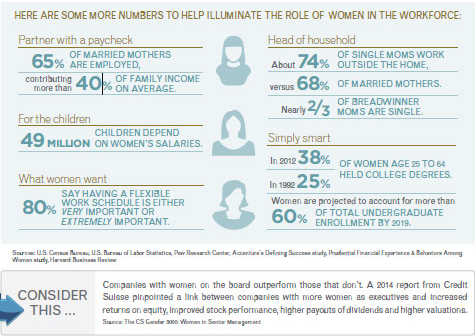Planning Perspectives
A look at life and finance from every angle.
From personal to professional, from family to financial, there are many facets to your life. Yet, each is interconnected. Planning Perspectives is a source of ideas and information to help you make the most of them all, all together.
More women have become economic forces within the modern workplace
All of those college degrees women are earning these days and the evolution of family structure has contributed to a mom phenomenon: in 2014, 69% of couple families with at least one child under 16 were dual-earner families, up from 36% in 1976. Among dual-earner families, almost three-quarters had two parents working full time in 2014, according to Statistics Canada.
In 2014, among the 27% of single-earner families, 16% had a stay-at-home mother and 2% had a stay-at-home father. Others (9%) had a parent that was either unemployed, attending school or permanently unable to work. What’s more is that Women – moms in particular – have become a major economic force, changing the modern workforce. Today, 71% of mothers with children at home are working, the Bureau of Labor Statistics reports; in 1962, the level was half that.
So, what does this mean?
For starters, the increase of women in the workforce has fueled U.S. economic growth. The economy is 13.5% bigger than it would have been if women hadn’t increased the time they spent working for pay since the 1970s, translating to an additional $2 trillion in gross domestic product, according to government estimates. GDP, the value of all the goods and services produced in a country, could be 5% higher if female employment rates matched those of males in the U.S., according to a 2012 study by Booz & Co. Women make up about 47% of the workforce in the United States.
Working mothers also have a positive influence on their children, according to a study released in May by Harvard Business School. The survey showed that daughters of working moms earned 23% more than those of stay-at-home mothers, and sons were more likely to help with housework and spend time caring for children and family as adults.
Finally, many of these breadwinner women are leading their family’s financial futures. In a 2014 study, 27% of married women said they take charge of financial and retirement planning, up from 14% in 2006. The same study pointed out that 53% of the women who turn to a financial advisor for guidance consider themselves on track or ahead of schedule on their financial goals.
Chances are you or someone you know is among these working women who help strengthen the economy, inspire a generation of children and take charge of their family’s financial well-being. It’s a tough job, but the rewards are many.
